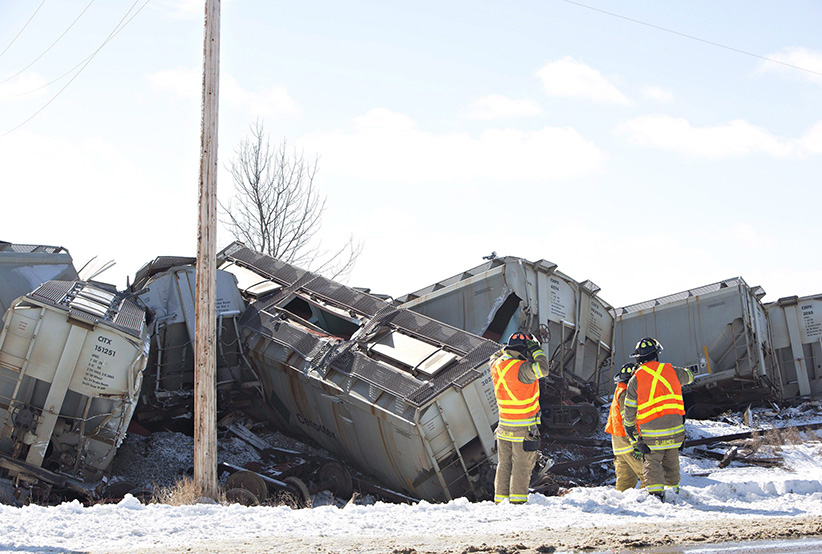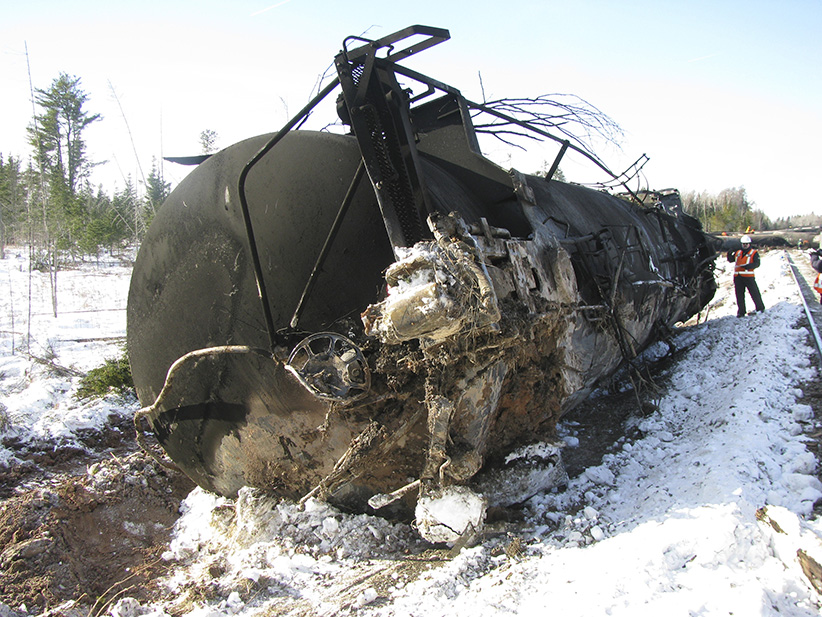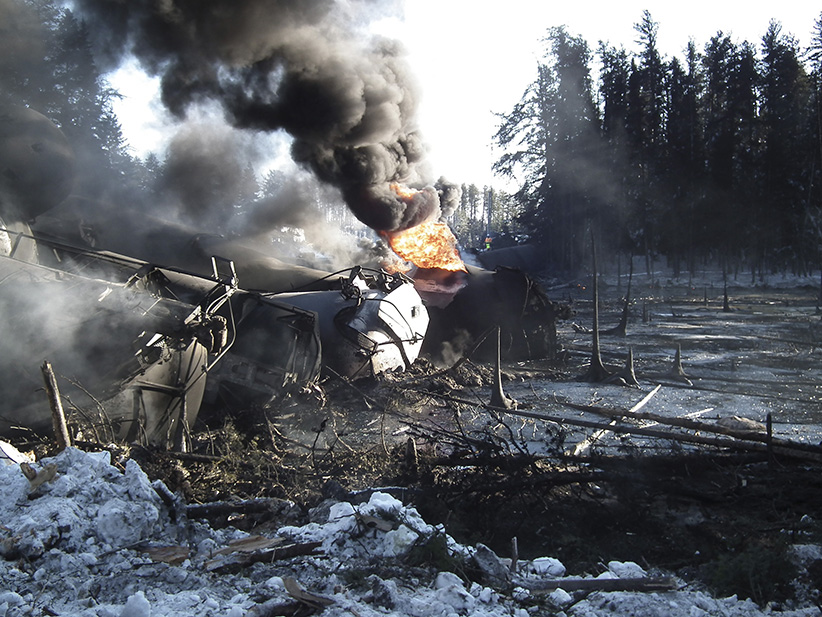Are train companies railroading Canadian communities?
Towns and cities across Canada are taking on powerful train companies over everything from speed to belligerence
Crews work to clean up after a CP Rail train carrying potash derailed east of Wetaskiwin, Alta., on Sunday, March 22, 2015. No one was injured when 15 cars derailed though some of the potash has spilled. Jason Franson/CP
Share

The elected leaders of Rivière-Verte, a postcard-pretty village in northwestern New Brunswick, do not have a reputation for wasting public dollars. With just 744 residents, a tax base of 354 dwellings and full slate of services to maintain, there’s little cash in the kitty for unnecessary spending, much less impulse buying. And for a town with neither a municipal police force nor a top-flight baseball team, a radar gun seems an especially extraneous expense.
But when Mayor Michel LeBlond sought permission last month to purchase a shiny new Bushnell Velocity—$119.99 online; accurate to within two kilometres an hour—his four fellow councillors couldn’t rubber-stamp the order fast enough. Like LeBlond, they’d long suspected that CN Rail trains were barrelling through their community faster than the mandated 84 km/h limit. And the danger had just hit home with a thud. The previous week, three rail cars carrying automobiles had jumped the tracks that flank the village to the southwest, two of them flopping over, BMWs tumbling about inside of them. The third somehow managed to stay upright, despite uncoupling from the rest of the train. At some point, a grass fire started on the bank of the St. John River.

The May 27 derailment was the latest of three within 16 months on just 10 km of the same track, a central trunk of the company’s transcontinental network. Two others occurred within the city limits of Edmundston to the north, and while neither resulted in injury or spills of dangerous goods, residents fear it’s a matter of time. In January 2014, 18 cars flew off the line—eight carrying propane or crude oil—about 90 km south, in the rural community of Wapske. Several cars caught fire and, fearing a calamitous explosion, emergency crews ordered residents of a nearby row of houses to flee. Some were out for as long as five days—watching in awe from the nearby town of Plaster Rock as crews conducted a so-called “vent-and-burn” that sent a massive fireball soaring above the treetops.
In each case, CN was as generous with reassurances as with the hotel expenses of evacuees. But as the wreckage piled up, LeBlond stopped listening. “We’re lucky the ones that went off here were car carriers,” says the 61-year-old high school teacher, scowling at twisted rails still littering the ground at the derailment site in his town. “There are oil cars going through here every day, and recent history is telling us that we cannot rely on the system to keep us safe.”
Walking past the tidy, white houses of his neighbours just a stone’s throw from the tracks, he acknowledges that federal authorities are taking a close look at track conditions in the area, while CN has been running its trains well below usual speeds. But answers are slow and scarce, LeBlond says, so once track repairs clear the way for normal operations, he plans to take the village radar gun to the bottom of Station Street and do a little fact-gathering of his own. “I just want to check for myself,” he shrugs. “See if they’re telling the truth.”
That’s not, strictly speaking, his job. As a federally regulated industry that doubles as a national symbol, Big Rail answers to Ottawa, and anyone without a Maple Leaf at the top of his letterhead can take a number. It’s the embodiment of a collective understanding of CN and CP Rail as critical infrastructure—engines of prosperity too important to the national interest to bog down in parochial whining. For local leaders tangling with these behemoths—invested with special statutory power and, often as not, the support of federal politicians—the battle planning can seem entirely futile.
That’s changing. In a period of rapid de-industrialization and urbanization, trains rumbling through the hearts of Canadian towns and cities seem to many residents remnants of a bygone, smoke-belching era, disrupting their sleep, delaying their traffic. Meanwhile, images of the disaster in Lac-Mégantic, Que., two years ago this month, remain etched in their minds, galvanizing citizens’ groups and activists against the movement of oil by rail. (Reports that CP Rail recently risked a Mégantic-like scenario in Revelstoke, B.C., leaving a train sitting above the town without handbrakes applied, brought it all rushing back; residents of the mountain town were outraged.)
In politics, fear plus frustration equals opportunity. When CP balked at Vancouver’s offer to purchase a disused stretch of track known as the Arbutus corridor, the city’s mayor, Gregor Robertson, got into a headline-grabbing battle with the company and its tough-talking CEO, E. Hunter Harrison, culminating in an ill-fated court action by the city that proved as popular as it was quixotic. His Calgarian counterpart, Naheed Nenshi, has been no less assertive, engaging CP over everything from noise to derailments to the partial collapse of one of the company’s bridges during the city’s flood-plagued summer of 2013, which left five petroleum-laden tanker cars teetering over the swollen Bow River. No single policy can explain Nenshi’s legendary popularity. But tilting at trains certainly hasn’t hurt him.
That these leaders have zero jurisdiction over the railroads doesn’t much matter. Cyrille Simard, the clean-cut, bilingual mayor of Edmundston, has won plaudits for his increasingly sharp criticism of CN over its lousy safety record in the area, including his recent demand for a personal audience with the company’s CEO, Claude Mongeau. With the main line cutting through his city of 16,000, Simard says, “not a day goes by when people don’t stop me and ask me if there’s something new on CN. They’re happy I’m being vocal.”
A track-side chat with constituents bears him out. “I think he should be speaking up,” says 72-year-old Albert Martin, a retired teacher who lives with his wife, Francine, beside the railway, just four kilometres from the site of a 35-car derailment last April. “Is it the condition of the rails? Is it the wheels on the cars? The speeds? He has to try to get some answers.”

Town versus train is by no means a new story in Canada. But it can be a reliable barometer of changes gripping the country. During the frenzied rail construction era of the 1920s, towns lobbied for railroads to come to their communities, so alluring were these links to the outside world, so profound the faith in their transformative power. “Think of modern Olympic bids,” says Ken Cruikshank, a McMaster University historian who has written about the period. “They’d bend over backwards, offering as much money as they could to attract and support the railway.”
Buyer’s remorse set in, Cruikshank adds, as either the railways didn’t live up to their promise, or the reality of having 10 tonnes of iron thundering through town hit home for the local citizenry. But the trains had by then become part of most Canadians’ daily lives. By the Second World War, ridership had reached 60 million passenger trips per year, CN was the country’s largest employer, and the railroads dominated the country’s transport network, buying up trucking companies, hotels and shipping lines.
Then, as quickly as it began, the love affair cooled. Highways and airlines (including CP’s own carrier) squeezed the train out of passenger travel, lowering annual ridership to five million by the late 1970s. For a time, the so-called Class 1 railways remained employment keystones. But deregulation, the privatization of CN and technological advances like mechanized rail-changers and computer-aided dispatch led to mass layoffs at both, and by 2006 employment by railways stood at 34,000, a 60 per cent decline from late-1980s levels. That’s roughly where it stands today.
Gone, then, are the days when the railroads touched our daily lives, when practically everyone in the country knew someone who worked for them. With them has gone the belief in the railways’ birthright to special treatment when dealing with communities. While every politician interviewed for this story affirmed belief in the critical importance of rail to the national economy—moving grain from the Prairies, oil from the oil sands, containers from the coasts—few thought their constituents identified all that closely with the railways. “Nowadays we just look at the trains go by,” says Edmundston’s Simard. “For a lot of people, it’s more a nuisance than anything else.”

That irritation can be heard in complaints arising from communities like Milton, a Toronto suburb struggling to remain livable as it grapples with a five-year growth rate of 56.5 per cent, the greatest of any municipality in the country. Earlier this year, CN stunned local residents by announcing plans to build a 160-hectare intermodal facility—essentially, a giant trans-shipping yard for freight containers—on land designated for Milton’s expansion. CN had abandoned a similar proposal 12 years earlier after encountering staunch resistance from residents. As a result, and at the behest of the Ontario government, local and regional leaders then incorporated the area into a managed growth plan. It was intended, says Gordon Krantz, the town’s long-time mayor, to be filled with retail stores, winding roads and quiet suburban neighbourhoods.
Instead, CN has resurrected its proposal to turn the area into a hive of trains, straddle cranes, lights, forklifts and containers, working 24/7 with as many as 1,600 trucks a day clogging municipal roads. There seems little anyone can do to stop them. The company bought up the property years ago under numbered companies, notes Krantz, knowing its special statutory powers allow it to override local or provincial land-use restrictions. “They’ve let me know they have the big stick,” he says. “They’ve not threatened me with it. But they make us aware that it’s ultimately them who will make the decision, regardless of what the local or regional elected people say.”
Stick or not, local groups want their leaders to fight. “This is wrong. Communities are being taken advantage of,” says Rita Vogel Post, who lives near the planned site and helped found the citizens’ group Milton Residents Affected by Intermodal Lines (Milton RAIL). “I want our local leaders to be as vocal as they can.” The pols appear to be listening. Councils in neighbouring Oakville, Burlington and Halton Hills have joined forces in opposing the project. When CN officials appeared before Halton Regional Council in late May to answer questions about their plan, the chairman, Gary Carr, blistered their ears. “It’s not right, it’s not fair and we’re going to fight you on this,” he said. “I’m not going to see this region destroyed.”
For now, Carr and Krantz must pin their hopes to a federal environmental assessment, and a review ordered by the Canadian Transportation Agency, the quasi-judicial body that handles complaints about railroads. Neither process is scaring CN off. The environmental assessment looks at the impact of the project on wildlife, birds, fish and Aboriginal communities, but not on residents. And while federal law allows the agency to consider the interests of local communities, those interests must be balanced “against requirements for railway operations and services.” Says Krantz: “They can pretty well do any damn thing they wish.”

Sometimes a dispute is defined by the personalities of its protagonists, and seldom is the dichotomy more glaring than in Vancouver’s spat with the Canadian Pacific Railway. On one side is CP’s chief executive, Hunter Harrison, a man who revels in the role of self-made railroad baron (“There’s a new sherriff in town,” he declared after winning a rancourous backroom battle for CP’s top job). On the other: Gregor Robertson, bicycle-riding, left-leaning founder of an organic-fruit beverage company who was propelled to the Vancouver mayoralty on a platform of making the city greener.
For Robertson, the fate of the land around CP Rail’s mothballed Arbutus line has become the sort of issue that symbolizes the policies and personality of a multi-term mayor. When trespassing gardeners planted vegetables and flowers along the corridor, he paid them visits, applauding their gentle act of disobedience. Then, last August, CP dispatched backhoes to the 11-km stretch and tore the gardens out.
On its face, the fight is about money. Harrison wasn’t satisfied with the $20 million the city had offered for the land, claiming last fall in an open letter to Vancouverites that the property could fetch as much as $400 million (CP’s reported asking price was $100 million). To ramp up pressure on the city, he announced CP’s intention to start running trains on the line for the first time in 12 years. “The new CP,” Harrison warned in his letter, “is not a company that will let this corridor lay dormant while discussions with the city drag on for another decade.” But for both men, it’s also about control. Robertson imagined the stretch as a greenway and light-rail corridor running through the middle of the city’s picturesque west side, and was horrified when CP, armed with a 2006 Supreme Court decision affirming its control of the land, sent in the bulldozer.

Vancouver’s attempt to obtain a permanent court injunction against CP’s reactivation plan failed, and while the trains haven’t started yet, Robertson is left pondering how the modern city is supposed to deal with the railways. In an interview, he stresses his respect for Vancouver’s historical importance as a rail terminus, saying the city has long had constructive relations with the railways. “But that’s completely fallen apart with CP,” he says. “Their lack of respect for the community has dug them a big hole.” While the dispute is nominally about money, it’s led Robertson to think the relationship between cities and railroads needs a reset: “Changes to the legislation governing railways are long overdue.”
The great irony? He and Harrison might at one time have made allies. Rail transport, after all, was the go-to solution of eco-conscious urbanites worried about climate change and traffic congestion—one Robertson touts to this day. But if the railways’ appetite for precious urban land has soured the relationship, their decision to embrace oil transport blew it to bits. Citing oil industry numbers projecting near-fourfold growth in movement of petroleum by rail within Canada, to 700,000 cars annually by 2016, residents of communities large and small have mobilized against oil trains coming through their communities.
Some are driven by environmentalist ideology, opposing the movement of oil by pipeline with the same fervour they do oil by rail. Others live in fear of a Lac-Mégantic redux—an anxiety that can sound paranoid given the rare convergence of human error, miscommunication, topography and bad luck that night in southern Quebec. One group billing itself as a nationwide “coalition of communities” has leafleted Toronto residents warning that, in the event of such a crash, that everything from homes to schools to nuclear power stations could be levelled within the 1.6-km “blast zone.”
Hyperbole, yes. But the math is worrying. Canadian railways are hauling 60 per cent more tonnage per employee than they were in 1999, raising concerns about whether they have the manpower to maintain safety. Derailments were up nearly 20 per cent in 2014, reaching 747, due largely to a rough year at CN. Fully 102 of those occurred on main tracks, and if you live near those routes—as millions do—it’s hard to ignore recent history.

Julie Simpson’s white, two-storey home stands steps from the CN tracks in Wapske, N.B., and on the frigid January day that the train crashed, she left the place with nothing but the clothes she was wearing. “I’d pulled on my boots without socks to go see what happened,” she says. “That fast, the fire department got there and said they were evacuating the area. We weren’t allowed to go back.”
She, her husband and about 150 others ordered from their homes that evening returned briefly the next day to gather up pets and a few essentials. But the scene at the tracks robbed them of comfort. Of the 16 derailed cars, 12 appeared to be tankers, at least two of which had leaked, forming a pond of flaming oil that seeped across an adjacent road. Other tank cars—apparently full—lay in the still-burning wreckage, so three days later crews conducted the vent-and-burn, detonating explosive charges at each end of one of the tankers to relieve the pressure inside. The idea was to safeguard firefighters from a devastating blast, but the intentional explosion was impressive in its own right, melting the siding and chimney mortar on a nearby house.
The federal transportation safety board later concluded that a faulty wheel on one of the cars had caused the accident. But to Simpson, the spectacle of that flaming lake, and the choreographed inferno, were all too reminiscent of the TV pictures she’d seen of Lac-Mégantic. “I’ve lived near the tracks since I was a child, and it got to the point you just didn’t notice it,” she says. “But let me tell you, since the derailment, I hear the trains. That sense [of security] is gone.”

Thus began a season of frightening close calls, including the Edmundston-area derailments and, astonishingly, two within three weeks of each other near the northern Ontario hamlet of Gogama. Both Ontario crashes involved tanker cars that ruptured and caught on fire—in one case as they lay leaking in the Mattagami River. With that, leaders like Stan Beardy, the Ontario regional chief of the Assembly of First Nations, sharpened their rhetoric. Aboriginal communities receive no notice about dangerous materials being moved across their traditional lands, noted Beardy, adding: “We are tired of being pawns in Canada’s addiction to oil.”
It’s hard to imagine a railway responding to that statement in a way that doesn’t sound self-serving. The crunch in pipeline capacity has created an unprecedented opportunity for the railroads, after all, driving a near-threefold rise in the monthly number of cars carrying petroleum products between 2011 and 2014, many of them headed to the U.S. The recent plunge in oil prices hasn’t slowed business: in 2014, CP’s revenues hit a record $6.62 billion, thanks in part to a 29 per cent increase in cash from crude shipments. CN’s profit climbed 21 per cent last year, to $3.17 billion, with continued growth in crude and natural gas shipments.
But CN, for one, rejects suggestions it is cutting corners on safety to harvest a windfall in oil shipments—or that it ignores the concerns of communities. The company makes a genuine effort to reach out to local stakeholders on issues like rail safety and transportation of dangerous goods, says Mark Hallman, the CN’s director of communications. “Bottom line,” he says, “CN is fully committed to running as safe a railway as it can.”
As for land-use issues, Hallman acknowledges that operations of an entity as unique as a railroad can cause conflicts with cities and towns. In the case of the Milton terminal, he says, CN revived the plan due to a quick change in market forces, noting that intermodal container shipping is now the company’s single largest business unit. The company approached municipal officials, he adds, to discuss the issue nearly a year before announcing its intent. “It’s not like it came out of nowhere,” Hallman says. “The company has been consistently open and eager and making significant efforts to have a dialogue about the terminal and how CN can accommodate the local concerns.”
CP, too, says it has consistently put safety first, pointing to an accident rate that has led North American railroads for the past nine years, according to a U.S. Federal Railway Administration number. With CN and other railways, notes CP president Keith Creel, it has invested in a restricted-use mobile app allowing first responders to determine the contents of any car by punching the ID number painted on the side of it into their smartphones. “Every policy we implement, every task we perform, every operational decision we make is viewed through the lens of safety,” Creel adds in an email. And the Arbutus line? “We are moving forward on our plan to resume operations along the Arbutus corridor,” he says. “We’ll do it safely and in compliance with all regulatory requirements.”

So are local leaders setting up the railways as political strawmen—targets they can attack without having to show results (they can always blame the feds)? Or are they airing legitimate complaints, starting a much-needed conversation about the place of railways in 21st-century Canada?
To be sure, their demands are varied and, in most cases, contingent on changes to federal law. Simard, in Edmundston, would like advance notice of dangerous goods moving through the city: for unspecified reasons of national security, municipalities currently get only quarterly reports after the fact. Gary Carr, the Halton chairman, asks why railway activities supersede municipal and provincial land-use plans. Calgary Mayor Naheed Nenshi suggests empowering communities to regulate narrowly defined railway activities, such as train movements that block rush-hour traffic. “We’ve taken tentative steps to making rail transport safer,” he says. “We need to think hard about the interface between railroads and cities.”
They’d best not hold their breath. Lisa Raitt, the federal minister of transport, believes the current laws and mechanisms allow communities to provide feedback. Over the past 15 years, she notes, governments have brought in changes requiring the railroads to consult more with municipalities on issues like locations of rails, facilities and crossings. On the safety front, she adds, the Conservatives moved quickly to strengthen regulations on oil transport, most notably by requiring the railways to upgrade or replace older tanker cars to make them more crash-resistant by 2017. “Everybody wants to operate in a safe culture,” she told Maclean’s last week. “People are not trying to get around the system, but if there are mistakes made they’ll be investigated and prosecuted.”
Still, politics is politics, and for all her confidence, Raitt can sense the vein of frustration her local counterparts are exploiting. The Milton terminal issue is proving particularly tricky for her: she’s the sitting MP for Halton, the riding in which it would be built; what’s more, the issue could land on the minister’s desk for a final verdict once the review process is exhausted. She’s consulted with the federal ethics commissioner, she says, and if the file reaches her office, or goes to cabinet, she’ll recuse herself from the discussion to avoid perceived conflict. In the meantime, she’s urging CN to do a better job engaging with local residents and governments if it wants its project to pass the federal review process.
Helpful advice. But the truth is that no act of goodwill on the railways’ part is likely to lower the temperature in Milton, or beyond. Carr now speaks openly of taking CN to court—“We’re going to challenge them every step of the way”—while Robertson is keeping up the PR war, depicting Harrison’s hard-line stand as a stain “on the CP brand.” Simard is awaiting his meeting CN’s top man—so far, the company has offered Sean Finn, its executive vice-president of corporate services. And if he gets it, he’s invited Michel LeBlond to come along.
What power the elected representative of 774 people wields before a company with $32 billion in assets isn’t clear. But for $119.99, he’ll have at least one tool in his kit. And it seems foolish to underestimate a mayor with a radar gun.